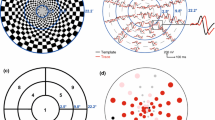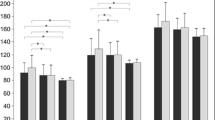Abstract
Purpose To compare conventional visual evoked potential (cVEP) and multifocal visual evoked potential (mfVEP) methods in patients with optic neuritis/multiple sclerosis (ON/MS). Methods mfVEPs and cVEPs were obtained from eyes of the 19 patients with multiple sclerosis confirmed on MRI scans, and from eyes of 40 normal controls. For the mfVEP, the display was a pattern-reversal dartboard array, 48° in diameter, which contained 60 sectors. Monocular cVEPs were obtained using a checkerboard stimulus with check sizes of 15′ and 60′. For the cVEP, the latency of P100 for both check sizes were measured, while for the mfVEP, the mean latency, percent of locations with abnormal latency, and clusters of contiguous abnormal locations were obtained. Results For a specificity of 95%, the mfVEP(interocular cluster criterion) showed the highest sensitivity (89.5%) of the 5 monocular or interocular tests. Similarly, when a combined monocular/interocular criterion was employed, the mfVEP(cluster criterion) had the highest sensitivity (94.7%)/specificity (90%), missing only one patient. The combined monocular/interocular cVEP(60′) test had a sensitivity (84.2%)/specificity (90%), missing 3 patients, 2 more than did the monocular/interocular mfVEP(cluster) test. Conclusion As the cVEP is more readily available and currently a shorter test, it should be used to screen patients for ON/MS with mfVEP testing added when the cVEP test is negative and the damage is local.


Similar content being viewed by others
References
Swanson JW (1989) Multiple sclerosis: update in diagnosis and review of prognostic factors. Mayo Clin Proc 64:577–586
Halliday AM, McDonald EI, Mushin J (1972) Delayed visual evoked response in optic neuritis. Lancet 1:661–664
Yang EB, Hood DC, Rodarte C, Zhang X, Odel JG, Behrens MM (2007) Improvement in conduction velocity after optic neuritis measured with the multifocal VEP. Invest Ophthalmol Vis Sci 48:692–698
Optic Neuritis Study Group (1991) The clinical profile of optic neuritis. Experience of the optic neuritis treatment trial. Arch Ophthalmol 109:1673–1678
Halliday AM, McDonald EI, Mushin J (1973) Visual evoked response in diagnosis of multiple sclerosis. BMJ 1:661–664
Hood DC, Odel JG, Winn BJ (2003) The multifocal visual evoked potential. J Neuro-Ophthalmol 23:279–289
Hood DC, Odel JG, Zhang X (2000) Tracking the recovery of local optic nerve function after optic neuritis: a multifocal VEP study. Invest Ophthalmol Vis Sci 41:4032–4038
Hood DC, Ohri N, Yang EB, Rodarte C, Zhang X, Fortune B, Johnson CA (2004) Determining abnormal latencies of multifocal visual evoked potentials: a monocular analysis. Doc Ophthalmol 109:189–199
Hood DC, Zhang X, Rodarte C, Yang EB, Ohri N, Fortune B, Johnson CA (2004) Determining abnormal interocular latencies of multifocal visual evoked potentials. Doc Ophthalmol 109:177–187
Fortune B, Hood DC (2003) Conventional pattern-reversal VEPs are not equivalent to summed multifocal VEPs. Invest Ophthalmol Vis Sci 44:1364–1375
Fortune B, Goh K, Demirel S, Novitsky K, Mansberger SL, Johnson CA, Cioffi GA (2003) Detection of glaucomatous visual field loss using the multifocal visual evoked potential. In: Henson DB, Wall M (eds) Perimetry update 2002/2003; Proceedings of the XVth international perimetric society meeting. Kugler, The Hague, pp 251–260
Hood DC, Greenstein VC (2003) Multifocal VEP and ganglion cell damage: applications and limitations for the study of glaucoma. Prog Retin Eye Res 22:201–251
Hood DC, Odel JG, Winn BJ (2003) The multifocal visual evoked potential. J Neuro-Ophthalmol 23:279–289
James AC (2003) The pattern-pulse multifocal visual evoked potential. Invest Ophthalmol Vis Sci 44:879–890
James AC, Ruseckaite R, Maddess T (2005) Effect of temporal sparseness and dichoptic presentation on multifocal visual evoked potentials. Vis Neurosci 22:45–54
Ruseckaite R, Maddess T, Danta G, Lueck CJ, James AC (2005) Sparse multifocal stimuli for the detection of multiple sclerosis. Ann Neurol 57:904–913
Odom JV, Bach M, Barber C et al (2004) Visual evoked potentials standard. Doc Ophthalmol 108:115–123
Baseler HA, Sutter EE, Klein SA, Carney T (1998) The topographic visual evoked potential: improving objective detection of local visual field defects. Invest Ophthalmol Vis Sci 39:937–950
Hood DC, Zhang X, Greenstein VC, Kangovi S, Odel JG, Liebmann JM, Ritch R (2000) An interocular comparison of the multifocal VEP: a possible technique for detecting local damage to the optic nerve. Invest Ophthalmol Vis Sci 41:1580–1587
Hood DC, Zhang X, Hong JE, Chen CS (2002) Quantifying the benefits of additional channels of multifocal VEP recording. Doc Ophthalmol 104:303–320
Hood DC (2004) Electrophysiologic imaging of retinal and optic nerve damage: the multifocal technique. Ophthalmol Clin N Am 1:69–88
Grippo TM, Hood DC, Kanadani FN, Ezon I, Greenstein VC, Liebmann JM, Ritch R (2006) A comparison between multifocal and conventional VEP latency changes secondary to glaucomatous damage. Invest Ophthalmol Vis Sci 47:5331–5336
Acknowledgements
This work was supported by National Institutes of Health, National Eye Institute Grants: RO1-EY02115 (DCH). Adam S. Wenick was funded by a fellowship from Fight for Sight, New York, NY, USA.
Author information
Authors and Affiliations
Corresponding author
Rights and permissions
About this article
Cite this article
Grover, L.K., Hood, D.C., Ghadiali, Q. et al. A comparison of multifocal and conventional visual evoked potential techniques in patients with optic neuritis/multiple sclerosis. Doc Ophthalmol 117, 121–128 (2008). https://doi.org/10.1007/s10633-007-9112-7
Received:
Accepted:
Published:
Issue Date:
DOI: https://doi.org/10.1007/s10633-007-9112-7




